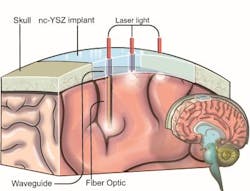Optically transparent skull implant shows promise for laser treatments of brain disorders
With the goal of creating a technology that will allow doctors to deliver life-saving laser treatments to patients with brain disorders, researchers at the University of California Riverside (UCR; Riverside, CA) have developed a transparent skull implant out of a biocompatible ceramic material.
Related: Transparent skull implant to ease laser treatment of brain conditions receives $5M in funding
The implant under development will allow doctors to deliver minimally invasive, laser-based treatments to patients with life-threatening neurological disorders, such as brain cancers, traumatic brain injuries, neurodegenerative diseases, and stroke. Two recent studies highlight both the biocompatibility of the implant material and its ability to endure bacterial infections.
The Window to the Brain project is a multi-institution, interdisciplinary partnership led by Guillermo Aguilar, professor of mechanical engineering in UCR's Bourns College of Engineering, and Santiago Camacho-López, from the Centro de Investigación Científica y de Educación Superior de Ensenada (CICESE) in Mexico.
The project began when Aguilar and his research team developed a transparent version of the material yttria-stabilized zirconia (YSZ)—the same ceramic product used in hip implants and dental crowns, and which is more impact-resistant than glass-based materials. By using this as a window-like implant, the team hopes doctors will be able to aim laser-based treatments into patients' brains on demand and without having to perform repeated craniotomies, which are highly invasive procedures used to access the brain.
The research team's most recent study, published July 8, 2016 in the journal Lasers in Surgery and Medicine, demonstrates how the use of transparent YSZ may allow doctors to combat bacterial infections, which are a leading reason for cranial implant failure. In lab studies, the researchers treated Escherichia coli (E. coli) infections by aiming laser light through the implant without having to remove it and without damaging the surrounding tissues. The finding, according to Devin Binder, MD, a neurosurgeon and neuroscientist in UCR's School of Medicine and a collaborator on the project, is important because it showed that the combination of the team's transparent implant and laser-based therapies enables them to treat not only brain disorders, but also to tackle bacterial infections that are common after cranial implants. These infections are especially challenging to treat because many antibiotics do not penetrate the blood brain barrier, he says.
Another recent study, published in the journal Nanomedicine: Nanotechnology, Biology and Medicine, explored the biocompatibility of YSZ in an animal model, where it integrated into the host tissue without causing an immune response or other adverse effects. The YSZ, Aguilar says, was found to be more biocompatible than currently available materials, such as titanium or thermo-plastic polymers.
The Window to the Brain project comprises faculty at UCR's Bourns College of Engineering and School of Medicine, together with researchers at the University of California, San Diego and three universities in Mexico: Centro de Investigación Científica y de Educación Superior de Ensenada (CICESE); Universidad Nacional Autónoma de México (UNAM); and Rubén Ramos-García, Instituto Nacional de Astrofísica, Óptica y Electrónica (INAOE) in Puebla. Yasaman Damestani, a graduate student in Aguilar's lab, was the lead author of these recent research studies.
In October 2015, the team received almost $5 million to advance the project over five years. $3.6 million was from the National Science Foundation's Partnerships in International Research and Education (PIRE) program, which pairs U.S. universities with others around the world. An additional $1 million was from Consejo Nacional de Ciencia y Tecnología (CONACYT), Mexico’s entity in charge of promoting scientific and technological activities. The remainder of the money came from in-kind contributions from the Mexican universities.
The team's long-term goal is to see the technology become the standard of care for patients with brain disorders who would benefit from laser-based treatments.


